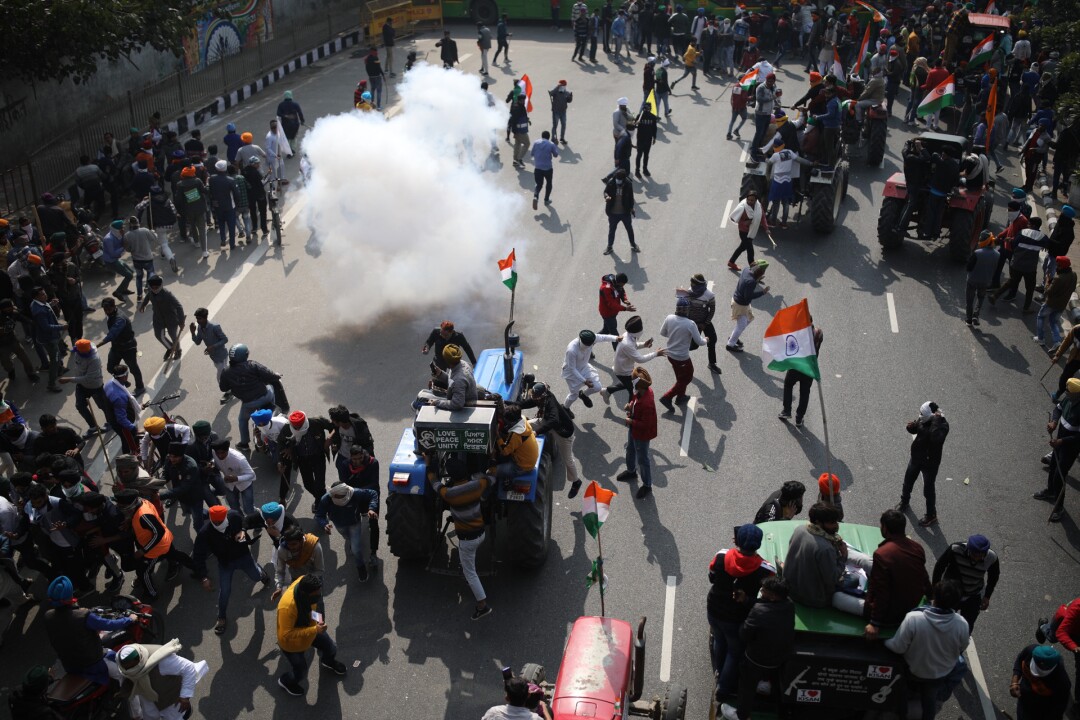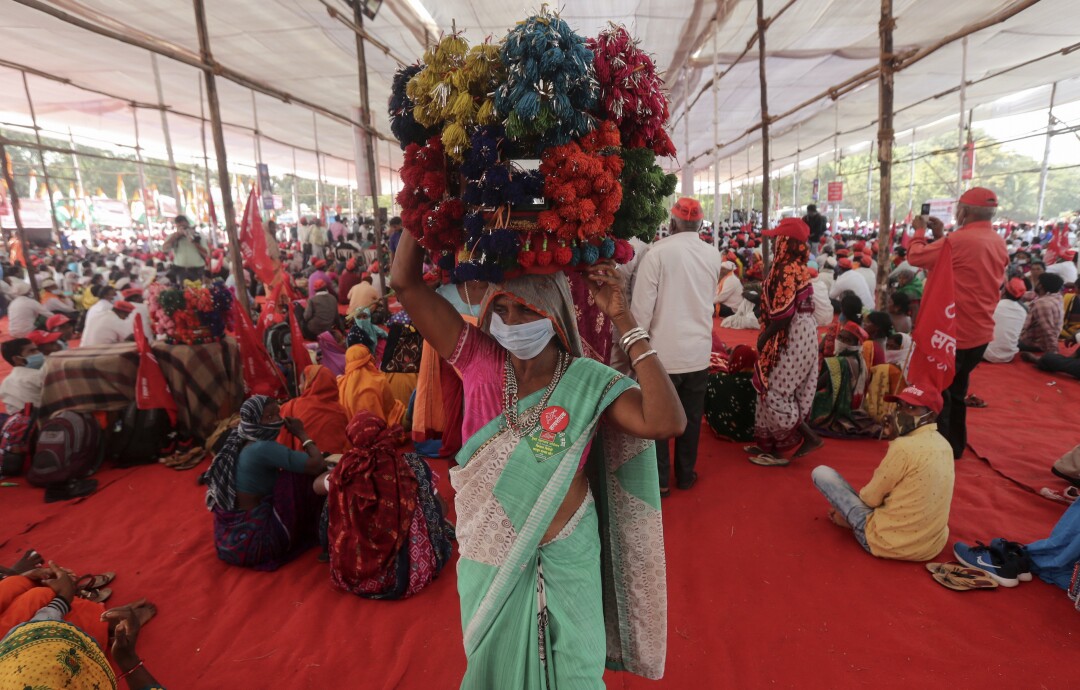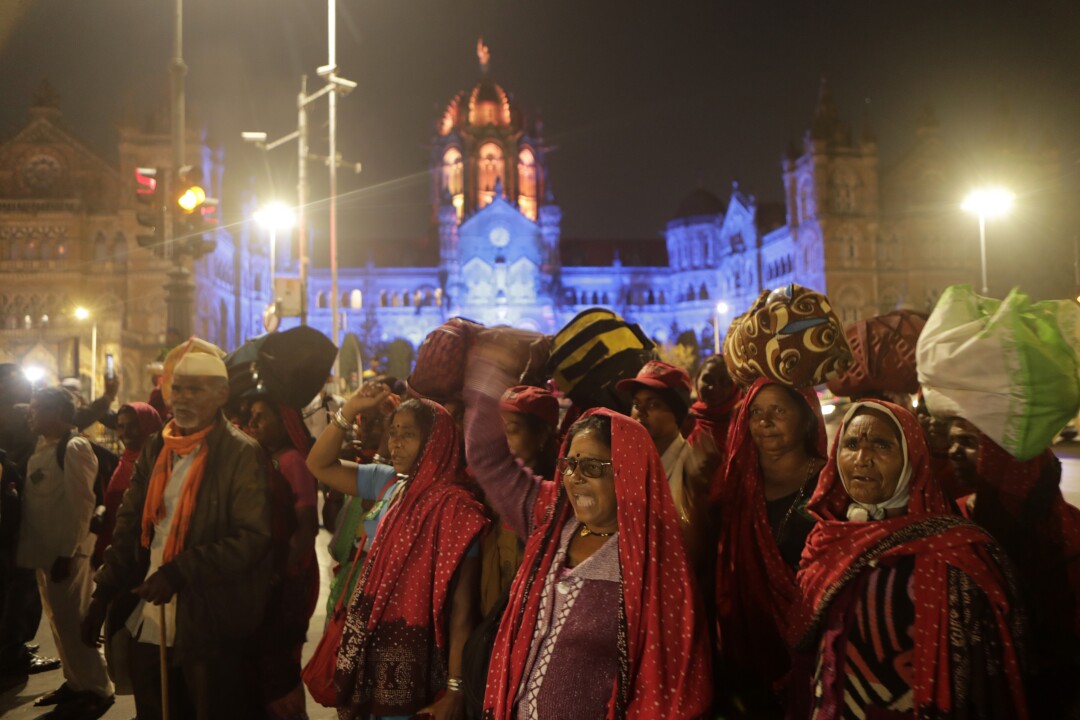Sunita Malik sat in the driver’s seat of her tractor, parked behind a police barricade at the edge of India’s capital.
She and her husband had come 60 miles from their farm in northern India to the gates of New Delhi, where hundreds of thousands of farmers have camped out for two months in bone-chilling cold in one of the biggest protests in the country’s history.
They are demanding that Prime Minister Narendra Modi’s government withdraw legislation aimed at boosting private investment in India’s heavily regulated farm sector, on which half of India’s 1.4 billion people depend for their livelihoods. They fear the laws will undermine the government price supports that prop up small-hold farmers and open the door to a corporate takeover of agriculture.
Popular agitation in India is nothing new, but these protests have captured national attention for their size and staying power — and for the role of women such as Malik, 45, who have pushed their way to the front lines in a striking show of gender equality among agrarian communities traditionally dominated by men.
“I learned to drive the tractor eight years ago,” said Malik, who owns 15 acres of land with her husband in Panipat, north of New Delhi. “There are many more women like me. It isn’t just men who drive tractors.”
Female farmers participate in a December protest against new farm laws at the Delhi-Haryana state border in India.
(Manish Swarup / Associated Press)
Malik spoke by phone Tuesday just hours before police fired tear gas and water cannons to break up a mass “tractor rally” that farmers held on the Republic Day holiday, a bid to upstage the government’s annual pomp-filled parade through central New Delhi. Protesters riding machinery and horses broke through barricades, and some hoisted religious and farm union flags atop the ramparts of the 17th century Red Fort, where the national flag customarily flies during the country’s independence celebration in August.
Farmers returned to their protest camps on New Delhi’s outskirts Wednesday, the morning after the clashes left one demonstrator dead and more than 100 police officers injured, according to Indian news reports.
Although protest groups had obtained permission to rally inside the capital, authorities said some farmers attacked police. Government officials denounced the demonstrators as dangerous radicals — one labeled their actions as an “insurrection against a democratically elected government” — and some farm unions distanced themselves from the violence, which marred weeks of peaceful sit-ins.
Top leaders in Modi’s government defend the laws as much-needed reforms for a farm sector they argue is bloated by subsidies and environmentally unsound.

Police use tear gas to disperse farmers who marched to New Delhi during India’s Republic Day celebrations on Tuesday.
(Altaf Qadri / Associated Press)
But many farmers said they would not end their protest until the government repealed the laws. They accused authorities of resorting to force because they were overwhelmed by the scale of the march.
“The police have stopped us because they did not expect to see as many farmers,” Malik said.
The presence of women — leading chants, cooking meals, sweeping up after crowds, preparing makeshift beds by the roadsides — points to the profound discontent that Modi’s government is facing in the countryside.

An elderly farmer sweeps a road in December outside New Delhi while participating in a protest of new farm laws.
(Manish Swarup / Associated Press)
Three-quarters of rural Indian women work in agriculture, a sector that has been left behind in the three-decade boom ushered in by the country’s economic liberalization. Agriculture accounted for about one-third of the economy in 1991 but now contributes just 15%.
The amount of arable land has shrunk, farms have been divided and subdivided — 86% of growers now operate on less than five acres — and erratic weather has devastated harvests. Thousands of cultivators have died by suicide because of financial pressures.
The protests have been driven by farmers in the northern agricultural belt surrounding Delhi who rely on state-sponsored markets, or mandis, that guarantee a minimum price for wheat and rice, as well as more than 20 smaller crops.
The laws hastily passed in September would allow private traders to buy directly from farmers, which opponents say would lead to the end of the mandi system, depress crop prices and allow large conglomerates to seize control of more of the nation’s produce. Since the northern state of Bihar dismantled its mandis more than a decade ago, farm incomes there have declined.
“Private companies will lure us initially by giving good rates,” Malik said. “But they will start exploiting us soon after that. We don’t trust them. They only understand profits.”

Protesting farmers dance during a rally in Mumbai, India, to oppose government-backed farm laws.
(Rafiq Maqbool / Associated Press)
Like many farm couples, Malik and her husband have protested in shifts, with one camping outside Delhi while the other tends to their wheat crop in Haryana state. She bristled at the comments by India’s chief justice, Sharad Bobde, who asked during a hearing this month: “Why are old people and women kept at the protests?”
“Women are the backbone of agriculture,” Malik said. “We wake up at 4 in the morning and toil in the fields. We are actively involved in every step of agriculture. The farm laws affect us directly. Why shouldn’t we protest?”
Despite the patriarchal traditions of the northern region — where nearly all land is held in men’s names and influential local councils still endorse practices such as underage marriage — the protests mark a rare broad-based social movement in India where women and men have stood side by side.
“I find it refreshing and welcome that more and more women are out in the open,” said R. Ramakumar, a professor of development studies at Mumbai’s Tata Institute of Social Sciences.
“Whether this visibility will lead to actual societal change, that’s something for the future. But it is a reflection of the resonance that the demands of this protest have in rural communities. Households see it as a matter of survival.”

Farmers gather in Mumbai, India, in support of protests against the government’s agricultural reforms.
(Rafiq Maqbool / Associated Press)
The Supreme Court this month ordered a stay on the implementation of the laws and convened a committee to meet with the government and protesters. Farm leaders have said they would not participate in a process they view as biased and have pledged to stage another major march to the Parliament building Monday.
Modi, who remains extremely popular in his second term despite allegations that his Hindu nationalist party is oppressing religious minorities, now finds himself in a standoff with a politically influential bloc that includes Sikhs from the northern state of Punjab.

Farmers from across India’s Maharashtra state arrive Sunday for a rally in Mumbai.
(Rajanish Kakade / Associated Press)
Some officials have painted the protests as limited to a handful of northern states, but the movement has begun to spread across India. More than 10,000 gathered this week in Mumbai’s Azad Maidan, a vast public lawn in the heart of the coastal city, and marched toward the Maharashtra state leader’s residence.
Leading the way were Indigenous village women such as 60-year-old Manjula Dhinda, who earns $3 a day as a farmworker and said she gave up four days of wages to join the march.
“Women do most of the work in the farmland,” she said. “Yet when we think of farmers, we imagine men. That is why it is important for more and more women to participate in farm protests.”

A woman rests her feet during a farmers’ rally Monday in Mumbai.
(Rafiq Maqbool / Associated Press)
Special correspondent Parth M.N. reported from Mumbai and Times staff writer Bengali from Singapore.






